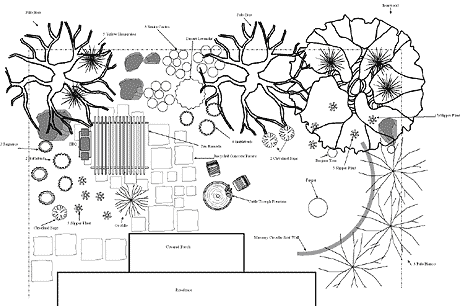William C. Welch, Extension Landscape Horticulturist
Editors Note: Planning the Home Landscape is one of Aggie-Horticulture’s most widely accessed educational resources. The Earth-Kind Edition of this resource highlights additional information (shown in red and emphasized) that can contribute to a healthy and sustainable environment while preserving and protecting our valuable natural resources.
A well-designed landscape is a pleasure to the owner, enhances a community, adds to the property’s resale value and limits environmental impact. Landscape design involves much more than placing trees, shrubs and other plants on the property. It is an art which deals with conscious arrangement or organization of outdoor space for human satisfaction and enjoyment. Some of its major goals include:
- Organizing and developing the site for maximum use and pleasure.
- Creating a visual relationship between the house and the site.
- Reducing landscape maintenance to a practical level.
- Assists in conserving energy
- Reduces environmental inputs such as water, fertilizers and pesticides.
Americans spend tremendous amounts of money “landscaping” their businesses, homes, streets, parks, schools, etc. Much of this money is wasted, however, because of little or no planning. People cannot understand how to landscape until they know why they landscape. There are several reasons why people “landscape”: some think it improves the appearance of their place; others like to grow plants; still others just want their place to look pretty. Too often these landscapes dominate rather than serve. Masses of plants or other materials in the landscape may take up a large portion of the space and leave little room for people.
Then how does the designer arrange space so that people will find it useful, beautiful, meaningful, functional, as well as environmentally sustainable? Useful methods include:
- Observing and analyzing the habits of the people who will be using the space, including their needs, desires and how much space each of their activities requires.
- Studying past methods.
- Surveying available materials to solve design requirements
- Analyzing the environment of the site including the view in and around the site.
- The ecology of the site should also be carefully analyzed since it is an important design determinant – noting areas and situations that might contribute to significant environmental impact (i.e. surface and groundwater contamination).
Not all landscaping improves the appearance of a building. The work of an insensitive designer can subdue a building, conceal important features or contradict the architect’s intent. Good landscape design can significantly improve the building’s appearance by adding warmth, liveability and personality. It can also relate a building to its site and environment and give it the desired degree of dominance.
Growth and change separate landscape design from other forms of art. Most works of art such as architecture, sculpture and painting look their best when new. Landscape designs, however, are at their worst when new and improve with age. A well-designed landscape will seldom look the same any two months of the year.
The temptation to begin planting immediately is almost overwhelming. Whether you are landscaping a newly-built home or redesigning an existing landscape, the results will be much more satisfying if you plan first.
Planning, design and installation will be critically important to the long-term maintenance of the landscape. This includes its impact on the environment. Mistakes or poor judgments at this stage of the process can result in excessive water use, potential contamination from fertilizers and pesticides, increased energy consumption, etc. Not only will these decisions impact the environment, they can significantly increase utility bills and other costs associated with maintaining the landscape.
Ideally, you should consult a professional landscape architect or designer on planning, but you can produce good results if you follow these steps.

